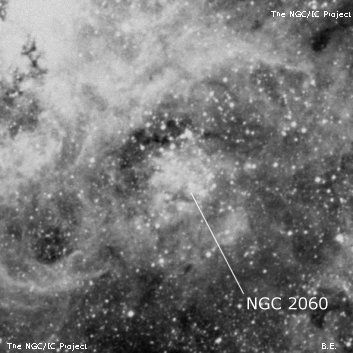
John Herschel discovered NGC 2060 between Nov 1836 and Mar 1837 with a 5-inch refractor and listed it as #642 in his preliminary catalogue of "Stars, Nebulae and Clusters in the Nubecula Major." (not included in his main CGH catalogue). His position corresponds with this SNR on the southwest side of the Tarantula nebula.
400/500mm - 18" (7/8/02 - Magellan Observatory, Australia): this fairly small knot of nebulosity is situated just southwest of the Tarantula nebula, approximately 7' from the center. About a half-dozen mag 12-14 stars are involved (association LH 99) in the glow with a total diameter of 2'. A mag 12 "star" at the north edge (Brey 73 = TLD1) is actually a very compact cluster with over a dozen components, including the Wolf-Rayet star.
NGC 2060 harbors a compact x-ray source and a rapidly rotating pulsar, indicating an obscured Crab-like supernova remnant (1998 IAU Circ., 6810, 2). The cluster also contains VFTS 102, the most rapidly rotating massive O-type star known, which is possibly related to the pulsar.
600/800mm - 25" (4/3/19 - OzSky): at 244x; Brey 73 appeared as a very high surface brightness knot (V = 12.1), ~12" diameter, with a mag 13.7 star at the SE edge.
Notes by Steve Gottlieb